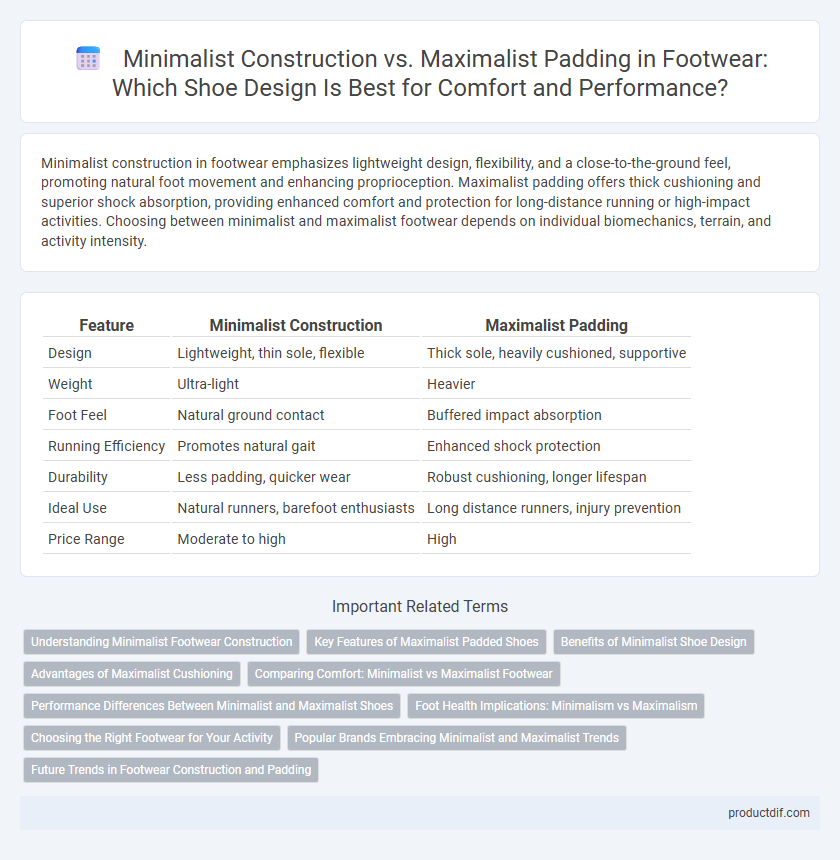Minimalist construction in footwear emphasizes lightweight design, flexibility, and a close-to-the-ground feel, promoting natural foot movement and enhancing proprioception. Maximalist padding offers thick cushioning and superior shock absorption, providing enhanced comfort and protection for long-distance running or high-impact activities. Choosing between minimalist and maximalist footwear depends on individual biomechanics, terrain, and activity intensity.
Table of Comparison
| Feature | Minimalist Construction | Maximalist Padding |
|---|---|---|
| Design | Lightweight, thin sole, flexible | Thick sole, heavily cushioned, supportive |
| Weight | Ultra-light | Heavier |
| Foot Feel | Natural ground contact | Buffered impact absorption |
| Running Efficiency | Promotes natural gait | Enhanced shock protection |
| Durability | Less padding, quicker wear | Robust cushioning, longer lifespan |
| Ideal Use | Natural runners, barefoot enthusiasts | Long distance runners, injury prevention |
| Price Range | Moderate to high | High |
Understanding Minimalist Footwear Construction
Minimalist footwear construction emphasizes lightweight design, flexible soles, and minimal cushioning to promote natural foot movement and strengthen foot muscles. These shoes typically feature thin, breathable materials, zero or low heel-to-toe drop, and minimal arch support to mimic barefoot walking. Understanding minimalist footwear helps runners and casual wearers improve proprioception and reduce injury by encouraging a more natural gait and foot strike.
Key Features of Maximalist Padded Shoes
Maximalist padded shoes feature thick midsoles designed to provide superior cushioning and impact absorption, enhancing comfort during long wear and high-impact activities. They often include layers of soft foam and gel inserts that reduce stress on joints and muscles, promoting better shock distribution. These shoes are ideal for runners and athletes seeking enhanced support and protection against fatigue and injury.
Benefits of Minimalist Shoe Design
Minimalist shoe design promotes natural foot movement by reducing excessive padding and structure, enhancing proprioception and balance during activities. This construction allows for greater flexibility and lightweight comfort, which can improve overall foot strength and reduce the risk of injury. By mimicking barefoot conditions, minimalist shoes encourage healthier gait patterns and long-term musculoskeletal benefits.
Advantages of Maximalist Cushioning
Maximalist cushioning in footwear offers superior shock absorption and enhanced comfort, reducing strain on joints during prolonged activities. The thick padding provides excellent energy return, improving performance and reducing fatigue. This design also supports better protection against uneven surfaces, making it ideal for long-distance runners and individuals requiring extra foot support.
Comparing Comfort: Minimalist vs Maximalist Footwear
Minimalist footwear emphasizes a lightweight design with thin soles and minimal cushioning, promoting natural foot movement and enhanced ground feel, which can improve balance and proprioception. Maximalist footwear features thick, highly cushioned midsoles that absorb impact and provide superior shock attenuation, ideal for runners seeking extra support and comfort over long distances. Comfort in minimalist shoes often depends on foot strength and adaptation, while maximalist shoes offer immediate padding benefits, catering to those prioritizing cushioning and joint protection.
Performance Differences Between Minimalist and Maximalist Shoes
Minimalist shoes enhance proprioception and promote natural foot mechanics by offering minimal padding and weight, improving agility and balance for performance-focused athletes. Maximalist shoes provide substantial cushioning and shock absorption, reducing impact stress and enhancing comfort, which benefits long-distance runners and those requiring injury protection. The choice between minimalist and maximalist footwear significantly affects running efficiency, injury risk, and overall foot biomechanics during athletic activities.
Foot Health Implications: Minimalism vs Maximalism
Minimalist footwear promotes natural foot mechanics by encouraging stronger foot muscles, improved balance, and enhanced proprioception, which can reduce the risk of common injuries such as plantar fasciitis. Maximalist shoes, characterized by thick cushioning and enhanced shock absorption, provide additional protection for joints and may benefit individuals prone to impact-related pain or conditions like arthritis. Selecting between minimalist construction and maximalist padding should consider individual foot anatomy, activity type, and specific foot health needs to optimize overall function and comfort.
Choosing the Right Footwear for Your Activity
Minimalist construction footwear offers lightweight design and enhanced ground feel, ideal for activities requiring agility and natural movement such as trail running or gym workouts. Maximalist padding provides superior cushioning and shock absorption, making it suitable for long-distance running or high-impact sports where joint protection is essential. Selecting the right footwear depends on understanding your activity's demands and balancing comfort, support, and performance features.
Popular Brands Embracing Minimalist and Maximalist Trends
Popular brands embracing minimalist construction in footwear include Vivobarefoot and Merrell, known for their lightweight designs promoting natural foot movement and flexibility. On the other hand, maximalist padding is championed by brands like Hoka One One and Altra, offering thick, cushioned soles designed to provide enhanced shock absorption and comfort for long-distance runners. These divergent trends cater to distinct consumer preferences, balancing foot protection and anatomical support with natural gait and ground feel.
Future Trends in Footwear Construction and Padding
Future trends in footwear construction emphasize a hybrid approach that blends minimalist design principles with targeted maximalist padding to optimize comfort and performance. Innovations in lightweight, responsive materials enable precise cushioning placement, enhancing natural foot biomechanics while maintaining minimal bulk. Advanced 3D printing and smart textiles drive customized solutions that adapt padding density and support based on individual gait analysis and activity demands.
Minimalist Construction vs Maximalist Padding Infographic

 productdif.com
productdif.com